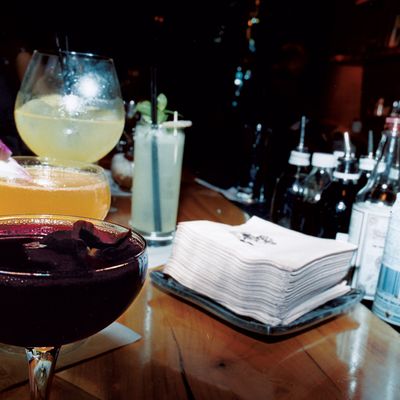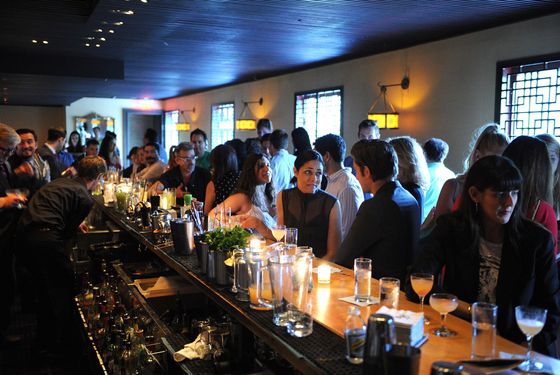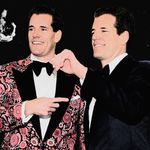
The first time cocktail historian and booze-world icon David Wondrich walked into Pegu Club he bumped into Barnaby Conrad III, a San Francisco–based author of influential books on the martini and absinthe. “Okay, this is awesome,” Wondrich recalls thinking. “This is what’s supposed to happen at this kind of bar.” That was nearly 10 years ago, and in the decade since Pegu Club first opened, it’s remained that kind of bar — one of the most significant cocktail destinations in the world.
Today, we’re far enough along in the mixology revival that we’ve reached the benchmark stage. In 2013, Flatiron Lounge celebrated its own 10-year anniversary. Last year, Employees Only did the same. And Milk & Honey, the earnest speakeasy that arguably inspired them all, would have recently turned 15 had it survived.
Pegu’s upcoming anniversary feels more historically momentous than the others. Its opening arrived at a time when the public’s taste for high-form whistle-wetting was ready to go mainstream, and the media was ready to take such stylish imbibing seriously. The Rainbow Room, run by Dale DeGroff, revived classic cocktails as an American culinary and social tradition; Milk & Honey brought cocktails down from the penthouse to the streets, suffusing the bartender’s art with a hushed, unapologetic seriousness; and Flatiron Lounge took that art — toned down a notch — to the masses. But by 2005 the movement still hadn’t quite come together in an accessible, haute package. Pegu, which arrived in August, was that package. And it was fronted by an opinionated, quotable figurehead who became central to the movement.
Audrey Saunders was schooled under DeGroff at the short-lived Blackbird and then furthered her reputation as a solo act at Beacon, Tonic, and finally Bemelmans Bar at the Carlyle. There, the Flatiron Lounge team (including Julie Reiner) approached her about opening a new bar. Its name alone signaled the seriousness of Saunders’s intentions: The Pegu Club was a favorite early-20th-century cocktail created at a British officers club in Rangoon, a mix of gin, bitters, curaçao, and fresh lime juice. It evoked an exotic, bygone world and telegraphed Saunders’s devotion to gin, a then-unfashionable spirit. “I knew that if I opened a bar called Pegu Club that bartenders who knew me would get it,” Saunders says. “People who hung out in the chat rooms would get it.”
In a world still awash in Amstel Light and cosmos, Pegu’s opening cocktail menu was a call to arms. There was a vermouth-heavy martini, renamed the Fitty-Fitty, alongside past Saunders creations, like the Gin-Gin Mule, the Old Cuban, and Earl Grey MarTEAni. Challenging, then-unfamiliar ingredients (Punt y Mes, Campari, Chartreuse) were commonplace. Each drink worked hard to get on the list: Saunders’s trial-and-error system became legendary. She’d enlist the staff to make, say, 25 versions of the same drink, each slightly different, until they hit on the right proportions and ingredients.
“Wrestling over details like a dash of bitters or not, or quarter-ounce versus a half-ounce, could go on for almost an hour for one cocktail,” remembers former Pegu bartender Phil Ward. “It was a lot to taste and sometimes a bit hazy to finish your shift afterward.”

The people behind the bar were just as formidable as the drinks. When Sasha Petraske was hiring at Milk & Honey, and Reiner at Flatiron, there was no craft-cocktail community, so they had to train everyone from the ground up. Saunders, however, was able to cherry pick the best of the new breed. Toby Maloney, chosen to be Pegu’s first head bartender, came from Milk & Honey, as did Chad Solomon. Phil Ward learned his trade at Flatiron. Jim Meehan worked at Pace and Gramercy Tavern. And Brian Miller learned from Jerri Banks, an early figure in the New York mixology movement. To this day, it is perhaps the most fearsome lineup of mixologists the modern bar world has ever known.
There were, of course, customers who showed up because they’d heard Pegu was the new hot spot. They’d order rum-and-Coke or vodka-soda and get nowhere. (Contrary to popular mythology, the bar did carry vodka.) Most customers, however, came to learn. “By that time, cocktails were catching on more,” Ward says. “There were more nerdier people. People went to Flatiron for cocktails. At Pegu, they came for cocktails and answers. They wanted to know shit.”
Shit like, What’s in that drink? Who invented it? Why are you stirring, and not shaking? For better or worse, mainstream mixology pedantry had begun. Pegu became a chrysalis of ideas and action, a place where important breakthroughs happened and the crusade was advanced. People noticed when the bar stocked previously unavailable ingredients (like Laird’s bonded applejack, which would become a favorite ingredient for many bartenders), or when Solomon began shaking cocktails without ice (first because it lessened the stress on his back, but soon after because people discovered “dry shaking,” as it would come to be known, helped better incorporate dairy and eggs).
Within a couple years, Pegu changed the entire scene, and the staff would soon disperse. In 2007, Ward and Miller left to help create Death & Company. Meehan opened PDT the same year. And today, nearly every significant ex-Pegu bartender has a bar of their own, including Jim Kearns (The Happiest Hour), Del Pedro (Tooker Alley), St. John Frizell (Fort Defiance) and Sam Ross (Attaboy). Another, Kenta Goto, will open his own place later this year.
As a result, New York cocktail bars worth serious consideration are pretty thick on the ground these days. Ironically, in such a fruitful atmosphere, Pegu Club itself often gets lost in the shuffle when the “best of” lists are compiled. That’s a shame. Even if the press caravan has moved on, the drinks and the bartenders are as good as ever. There are maybe nine or ten cocktail bars in New York where you can order any drink on a menu and not get a loser. Pegu is one of them. Yes, the menu itself, and the atmosphere feel a bit frozen in time now. But, oh, that was a great time.




